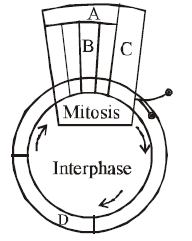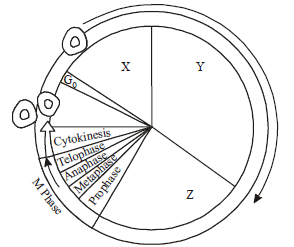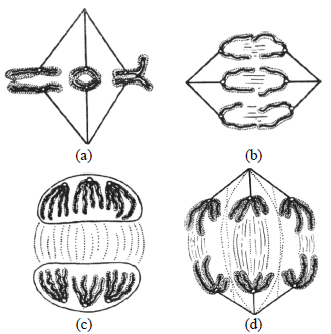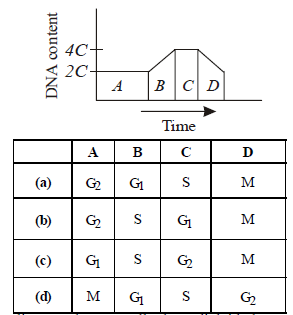Please refer to Cell Cycle and Cell Division Class 11 Biology Important Questions with solutions provided below. These questions and answers have been provided for Class 11 Biology based on the latest syllabus and examination guidelines issued by CBSE, NCERT, and KVS. Students should learn these problem solutions as it will help them to gain more marks in examinations. We have provided Important Questions for Class 11 Biology for all chapters in your book. These Board exam questions have been designed by expert teachers of Standard 11.
Class 11 Biology Important Questions Cell Cycle and Cell Division
Objective Questions
Question. In cell cycle, DNA replication takes place in ______
(a) G1 phase
(b) G2 phase
(c) Mitotic metaphase
(d) S phase
Answer
D
Question. Interphase includes all of the following except ______
(a) G1 phase
(b) Anaphase
(c) S phase
(d) G2 phase
Answer
B
Question. Which of the following phase follows S and G2 phases of interphase?
(a) Prophase
(b) Metaphase
(c) Anaphase
(d) Telophase
Answer
A
Question. What is the stage of mitosis in which chromosomes are arranged on the equator of spindle?
(a) Anaphase
(b) Prophase
(c) Metaphase
(d) Telophase
Answer
C
Question. In anaphase of mitosis,
(a) chromosomes get arranged in middle of cell.
(b) nuclear envelope disappears.
(c) chromosome fibres become clear.
(d) chromosomes aggregate at opposite poles to form daughter nuclei.
Answer
D
Question. In meiosis, division is
(a) Ist reductional and IInd equational.
(b) Ist equational and IInd reductional.
(c) both reductional.
(d) both equational.
Answer
A
Statement Type Questions
Question. Select the correct statement with respect to mitosis.
(a) Chromatids separate but remain in the centre of the cell in anaphase.
(b) Chromatids start moving towards opposite poles in telophase.
(c) Golgi complex and endoplasmic reticulum are still visible at the end of prophase.
(d) Chromosomes move to the spindle equator and get aligned along equatorial plate in metaphase.
Answer
D
Question. Significance of mitosis involves
(a) the growth of multicellular organism.
(b) cell repair.
(c) production of diploid daughter cells with identical genetic complement.
(d) all of the above
Answer
D
Question. Which one is correct about crossing over/genetic recombination?
(i) It occurs in tetrad stage which occurs in pachytene of prophase I of meiosis I.
(ii) It occurs between non-sister chromatids of homologous chromosomes.
(iii) It is recombinase enzyme mediated process.
(iv) It is also the reciprocal transfer of genes between the non-homologous chromosomes
(a) All of the above
(b) All except (iv)
(c) (ii), (iii) and (iv)
(d) (iii) and (iv)
Answer
B
Assertion/Reason Type Questions
In the following questions, a statement of Assertion is followed by a statement of Reason.
(a) If both Assertion and Reason are true and the Reason is the correct explanation of the Assertion.
(b) If both Assertion and Reason are true but the Reason is not the correct explanation of the Assertion.
(c) If Assertion is true but Reason is false.
(d) If both Assertion and Reason are false.
Question. Assertion: The stage between two mitotic divisions is called interkinesis.
Reason: Interkinesis is generally short lived.
Answer
D
Question. Assertion: Interphase occupies 75-95% of the total generation time.
Reason: Interphase (I-phase) is the long non-dividing phase.
Answer
A
Matching Type Questions
Question. Match the description (given in column I) with correct stage of prophase I (given column II) and choose the correct option.
| Column I | Column II |
| A. Chromosomes are moved to spindle equator | I. Pachytene |
| B. Centromere splits and chromatids apart | II. Zygotene |
| C. Pairing between homologous chromosomes takes place | III. Anaphase |
| D. Crossing between homologous chromosomes | IV. Metaphase |
(a) A – I; B – II; C – III; D – IV
(b) A – II; B – III; C – IV; D – I
(c) A – IV; B – III; C – II; D – I
(d) A – III; B – I; C – IV; D – II
Answer
C
Question. Match the description given in column-I with their stapes given in column-II and identify the correct answer.
| Column-I | Column-II |
| A. Initiation of the assembly of mitotic spindle | I. Anaphase |
| B. Proteins are synthesized in preparation for mitosis while cell growth continues. | II. Prophase |
| C. Spindle fibres attach to kinetochores of chromosomes. | III. Interphase |
| D. Movement of chromatids towards opposite poles | IV. Metaphase |
The correct match is
(a) A – II; B – III; C – IV; D – I
(b) A – III; B – II; C – I; D – IV
(c) A – I; B – III; C – II; D – IV
(d) A – IV; B – III; C – I; D – II
Answer
A
Question. Find the correctly matched pairs and choose the correct option.
A. Zygotene – Pairing of homologous chromosomes
B. Pachytene – Dissolution of the complex synaptonemal takes place
C. Diplotene – Bivalent chromosomes appear as tetrads
D. Diakinesis – Terminalization of chiasmata takes place
(a) A and C
(b) A and D
(c) A and B
(d) B and C
Answer
B
Diagram Type Questions
Question. Given below is a schematic break-up of the phases / stages of cell cycle with few parts labelled as A, B, C & D.

Which one of the following is the correct indication of the stage/phase in the cell cycle?
(a). C – Karyokinesis
(b) D – Synthetic phase
(c) A – Cytokinesis
(d) B – Metaphase
Answer
B
Question. Given below is the representation of a certain event at a particular stage of a type of cell division. Which stage is shown by the given figure?

(a) Prophase I during meiosis.
(b) Prophase II during meiosis.
(c) Prophase of mitosis.
(d) Both prophase and metaphase of mitosis.
Answer
A
Question. The following diagram is of a typical cell cycle indicating formation of two cells from one cell.

Choose the correct option showing the correct identification of X, Y, & Z.
(a) X – G1; Y – S; Z – G2
(b) X – G2; Y – S; Z – G1
(c) X – G0; Y – S; Z – G2
(d) X – G1; Y – G0; Z – S
Answer
A
Question. Choose the diagram which correctly depicts anaphase I.

Answer
D
Question. Identify the phases from the graph given below that shows the change in DNA content during various phases (A to D) of mitotic cell cycle.

Answer
C
Critical Thinking Type Questions
Question. In the somatic cell cycle
(a) In G1 phase, DNA content is double the amount of DNA present in the original cell.
(b) DNA replication takes place in S-phase.
(c) a short interphase is followed by a long mitotic phase.
(d) G2 phase follows mitotic phase.
Answer
B
Question. How many mitotic divisions are needed for a single cell to make 128 cells?
(a) 7
(b) 14
(c) 28
(d) 64
Answer
A
Question. Significance of meiosis lies in
(a) reduction of chromosome number to one half.
(b) maintaining consistancy of chromosome number during sexual reproduction.
(c) production of genetic variability.
(d) all of the above.
Answer
D
Question. Mitosis and meiosis take place respectively in
(a) meristem and gametangia.
(b) gametangia and meristem.
(c) permanent tissues and secretory tissues.
(d) secretory tissues and permanent tissues.
Answer
A
Question. Which of the following is the result when karyokinesis is not followed by cytokinesis ?
(a) Synaptonemal complex
(b) Syncytium
(c) Recombination nodules
(d) Terminalization
Answer
B

